
Monsoon smashes Mumbai: Delayed trains, falling trees, traffic gridlocks
What's the story
Mumbai was battered by heavy rains and strong winds yesterday, which damaged vehicles, uprooted 21 trees, caused massive traffic gridlocks and injured two people. On Saturday too, the rainfall had high intensity, but it gathered more momentum Sunday. Weather experts predicted that from tomorrow, rainfall will be sporadic. Dry weather will prevail till June 22.
Details
Mulund, Powai, Bhadup received maximum rains, remained submerged in water
While Colaba recorded 50.6 mm of rains, Santacruz weather station clocked 23.4 mm rainfall on Sunday. Among all the suburbs, Mulund East and West, Powai and Bhandup West received the maximum rainfall. All these areas were submerged in water temporarily. BMC's disaster control room received 21 tree-felling complaints, with a tree damaging five high-end cars parked near Thane's Teen Hath Naka.
What else
One injured in wall collapse, rescue-teams fighting to clear debris
BMC said no one was inside the cars damaged at Teen Hath Naka, but it took four hours for 10 firemen and five personnel from disaster management cell to clear the debris. In Jogeshwari, a man sustained minor injuries after a building-wall collapsed. Kurla, Malad, Dadar, Hindmata, Chunabhatti and Kalina saw waterlogging, but with pumps in place, it was flushed out on time.
Mumbai
Monsoon till now: 587 tree-felling incidents, six short circuit cases
The torrential rains also affected train services on all three suburban railway lines. Since megablocks were reported on some train routes, many people took to roads. This resulted in traffic jams on the Eastern Express Highway and Link Road between Andheri and Kandivli. This monsoon, Mumbai has seen 587 tree-felling incidents and six short-circuit cases till now.
Flaws
Are BMC's monsoon measures enough?
No matter how much BMC prepares, nothing can help the city from facing major civic issues. Mumbai has old and inadequate drainage, with open drains remaining choked with garbage. With rising urbanization, mangroves are slowly vanishing. This means there is no catchment area for the rains. Most importantly, all the measures taken are post-monsoon. By then, the damage is already done.